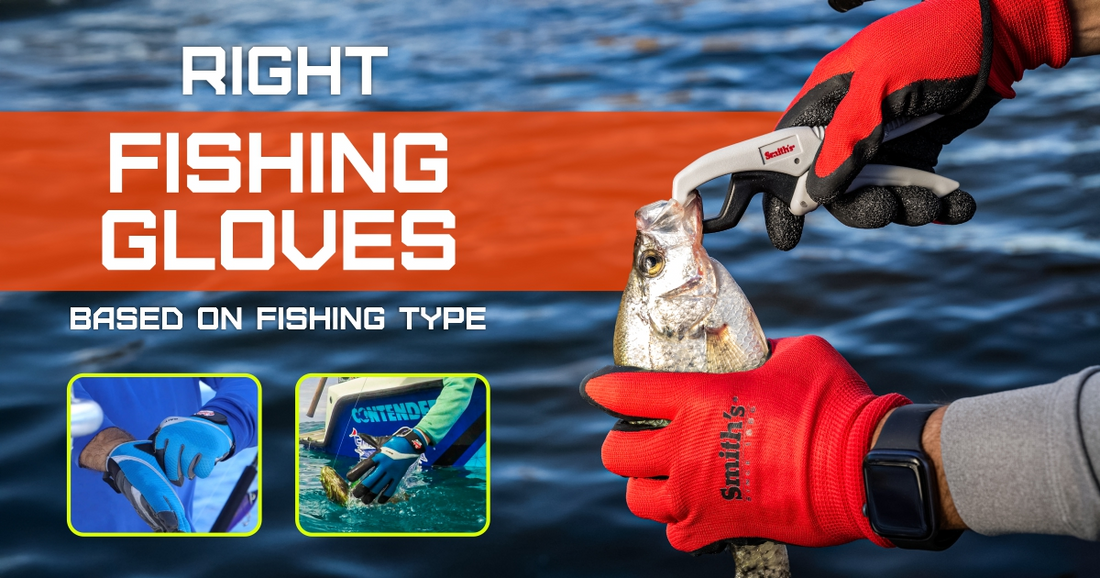
How to Choose the Right Fishing Gloves Based on Fishing Type
Share
When you're out on the water, the last thing you want is discomfort or injury slowing you down. Fishing gloves are essential gear, not just for comfort, but also for protection and performance. However, not all gloves are made equal—choosing the right pair depends largely on the type of fishing you do. In this comprehensive guide, we’ll help you understand what to look for in fishing gloves based on your specific fishing style.
Why Are Fishing Gloves Important?
Fishing gloves do more than keep your hands warm. They offer:
- Protection from hooks, fish teeth, and fins
- UV shielding for long days in the sun
- Improved grip when handling fish or wet gear
- Temperature regulation in extreme weather
In the United States, fishing environments vary greatly—from icy lakes in Minnesota to deep-sea adventures off the Florida coast—so selecting the right gloves can significantly enhance your fishing experience.
Key Features to Consider in Fishing Gloves
Before diving into fishing-type-specific recommendations, here are some general features to look for:
- Material: Neoprene, synthetic leather, and microfiber offer different balances of flexibility, warmth, and durability.
- Grip: Silicone or rubberized palms help you maintain control.
- Water Resistance: Vital for colder climates or deep-sea fishing.
- UV Protection: Important for sunny, open-water fishing.
- Breathability: Crucial for comfort during long freshwater or fly fishing sessions.
- Finger Design: Full-finger, half-finger, or convertible styles can suit different needs.
1. Saltwater Fishing Gloves
Saltwater fishing, especially off coasts like Florida or California, demands tough, durable gloves. You're dealing with larger fish, corrosive saltwater, and heavy-duty gear.
What to Look For:
- Saltwater resistance: Choose materials that won't degrade in salt environments.
- Strong grip: You’ll need it for slippery fish like tuna or snapper.
- Full-finger design: For maximum protection against sharp fins and hooks.
- Cut resistance: Helpful when handling wire leaders or filleting fish on the spot.
Recommended Glove Type:
Heavy-duty, full-finger gloves with reinforced palms and salt-resistant materials.
2. Freshwater Fishing Gloves
Freshwater fishing is popular in lakes, rivers, and ponds across the U.S. from the Great Lakes to southern streams.
What to Look For:
- Lightweight and breathable: Conditions aren’t as harsh as saltwater.
- UV protection: Especially in open areas like lakes.
- Flexibility: You’ll need more hand mobility to tie knots or handle tackle.
Recommended Glove Type:
Fingerless or convertible gloves with UV protection and breathable mesh or microfiber.
3. Fly Fishing Gloves
Fly fishing requires precision, often in cold streams or rivers with lots of hand movement and line control.
What to Look For:
- Fingerless design: Maximizes dexterity for casting and knot-tying.
- Water resistance: Keeps hands dry without sacrificing movement.
- Slim fit: Ensures better rod handling.
Recommended Glove Type:
Neoprene or fleece-lined fingerless gloves for cool conditions, or lightweight sun gloves for warm weather.
4. Ice Fishing Gloves
Ice fishing in states like Wisconsin or Michigan demands extreme cold protection.
What to Look For:
- Insulation: Thermal or fleece-lined gloves are a must.
- Waterproofing: Ice and water will eventually get everywhere.
- Dexterity: Despite the bulk, you still need some movement to handle lines and lures.
Recommended Glove Type:
Thick, waterproof, full-finger insulated gloves with grip-enhancing surfaces.
5. Kayak Fishing Gloves
Kayak anglers need gloves that balance paddle handling and fishing function.
What to Look For:
- Padded palms: Reduces friction while paddling.
- Quick-dry fabric: You’ll get wet constantly.
- Half-finger or convertible style: Allows casting and bait setup.
Recommended Glove Type:
Lightweight, padded, quick-drying gloves with finger flexibility.
6. Deep Sea Fishing Gloves
Offshore or big game fishing involves heavy tackle and larger, aggressive fish.
What to Look For:
- Heavy-duty materials: Protects from bites, spikes, and hooks.
- Shock absorption: When reeling in large fish.
- Non-slip grip: Crucial in rocking boats.
Recommended Glove Type:
Industrial-strength full-finger gloves with leather or Kevlar-reinforced palms.
Seasonal Considerations in the U.S.
Spring & Summer
- Go for lightweight, breathable gloves with UV protection.
- Popular glove types: fingerless and convertible.
Fall & Winter
- Focus on insulation and waterproofing.
- Popular glove types: full-finger, neoprene, and thermal gloves.
How to Choose the Right Size and Fit
Improperly fitting fishing gloves can lead to blisters or lost dexterity. Follow these tips:
- Measure your hand around the knuckles for width.
- Opt for snug but not tight gloves—especially for winter.
- Try on with fishing gear if possible (rod, reel, tackle).
Top Brands for Fishing Gloves in the U.S.
Some reliable glove brands used by anglers across the country include:
- Simms
- Fish Monkey
- KastKing
- Glacier Glove
- Rapala
These brands offer fishing gloves for all types—from lightweight sun gloves to cold-weather insulated models.
Final Thoughts
Choosing the right fishing gloves depends entirely on where, when, and how you fish. Whether you're battling trout in a chilly Colorado stream or chasing marlin off the Gulf Coast, there’s a perfect glove designed for your needs.
Remember, your gloves should serve as an extension of your hands—offering protection, comfort, and control. Invest wisely, and your hands will thank you during every cast, catch, and release.
